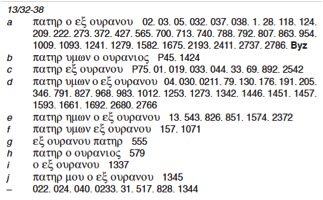
Guide
Underlying data
This application is based on data published in Novum Testamentum Graecum – Editio Critica Maior: Parallel Pericopes, ed. H. Strutwolf and K. Wachtel, Stuttgart: Deutsche Bibelgesellschaft 2011.
This volume comprises full collations of 159 manuscripts in 41 parallel pericopes, including two from the Gospel of John and one from 1 Corinthians. The apparatus lists a total of 1568 variant passages. The database for the present tool is restricted to the three Synoptic Gospels, i.e. to 157 manuscripts at 1405 variant passages. (P66 and P46 were included in the apparatus for the Jn and 1Cor pericopes.)
Note that only the text of the first hand is included for the present application; texts of other hands are not included.
Methodological Background
“Find Relatives” is a tool that links groupings as shown by “Manuscripts Clusters” to the attestations of variant passages. Thus groupings can be utilized to retrieve relationships between variants. In the context of the Coherence-Based Genealogical Method (CBGM) this is called the analysis of pre-genealogical coherence.
Lk 11:13/32-38c as an example

Extract from Strutwolf and Wachtel, Parallel Pericopes, p. 15
In the Editio Critica Maior (ECM), variant passages are identified by book (Lk), chapter (11), verse (13), first word of the passage (32) and last word of the passage (38). An individual variant is tagged by a letter (c).
Enter the “address” of this variant into the input mask and click GO!
In the resulting list the witnesses of Lk 11:13/32-38c are displayed in bold typeface together with their respective percentages of agreement with the majority text (MT). Each of them is followed by a compilation of its closest relatives, according to the simple grouping criterion. The lists following bold witness numbers are similar to the output of Manuscript Clusters. The first under P75 is 03, agreeing at 96.3% of the variant passages they share in the pericopes from the three Synoptics. The last position in the line indicates that 03 supports variant a which is the majority reading (M) at this passage. Second after 03 is A, the reconstructed initial text or Ausgangstext according to NA27. (A does not appear as a witness in the edition.) The third relative assigned to P75 is 019 attesting to the same variant c, etc.
As in “Manuscript Clusters” the simple grouping criterion includes all manuscripts that agree with a specified ms. more often than the specified ms. agrees with the majority text. The line referring to P75 says that this ms. supports the majority text (MT) at 86% of the variant passages for the pericopes included from the Synoptics. The mss. agreeing with P75 at more than 86% are listed below, ordered by descending percentages of agreement.
Open “Manuscript Clusters” in a separate window, then enter P75 to see the correspondence between the resulting group and the range of witnesses aligned with P75 in “Find Relatives”.
Returning to the “Find Relatives” window, the second witness of variant c, 01, shows relationships with two manuscripts supporting neither a nor c itself but d: manuscripts 04 and 1342. These recur in the list under the next witness, 019.
For 033, the fourth witness of variant c, no relationship is indicated: hence it has no close relative according to the evidence included in Parallel Pericopes. For 044 there are only four entries, three of which point to a, while one is aligned to d. Like 01 and 019, minuscule 33 shows relationships to witnesses supporting a, c and d. With 69 one more variant is suggested for consideration: e.
We can suppress MT entries if we want to see which variants, apart from the majority reading, may be interrelated with the variant in question.
Open a new browser window
go to “Find Relatives”
enter Lk 11:13/32-38c
select “Display: Excl. Majority Text”
click GO!
The output gives a quick overview of the variants in question. The running numbers preceding ms. numbers listed with witnesses of the variant are no longer identical, as they were with “Display: Incl. Majority Text”. The first number simply counts the entries according to the current parameters, the second number shows what the current number of an entry would be with “Incl. Majority Text” selected.
Now more relationships come into view. For 019 the last three entries would have had positions 20, 37 and 48 with “Incl. Majority Text” selected. With 69, however, the range of related manuscripts remains the same.
Open a new browser window
go to “Find Relatives”
enter Lk 11:13/32-38c
select “Grouping: Strict”
click GO!
By analogy with “Manuscripts Clusters”, the strict grouping criterion includes all manuscripts that agree with the specified ms. more often than the specified ms. and a comparator ms. agree with the MT. There are at least 10 manuscripts that meet this criterion with respect to P75 in the pericopes included from the Synoptic Gospels.
Open a new browser window
go to “Find Relatives”
enter Lk 11:13/32-38c
select “Grouping: Strict”
select “Display: Excl. Majority Text”
click GO!
The output shows which variants, apart from the majority reading, are related to variant c according to their witnesses. Obvious candidates, at least for 69, are variants e and d. The second running number in each row refers to the position of the respective ms. with “Grouping: Strict” and “Display: Excl. Majority Text” selected.